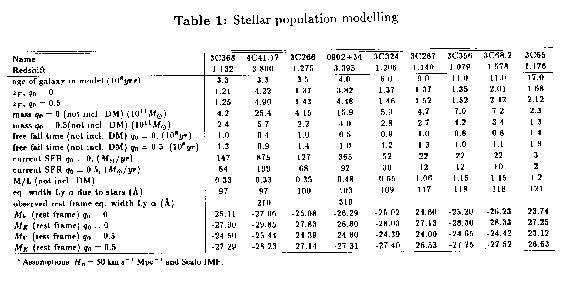The spectral energy distribution (SED) of high redshift radio galaxies show a
"flat ultraviolet plus a red bump". Lilly (1988) proposed that the red bump was
was caused by an old ( Gyr) population, while the rest frame ultraviolet
light could be produced by a small fraction of the galactic mass currently
undergoing a starburst. Chambers and Charlot (1990) investigated whether the
SED could be explained by starformation scenarios involving shorter timescales.
They used and updated version of the Bruzual (1983) code of stellar population
synthesis. This program is nothing more than a large database containing
spectra of different type of stars. By filling in the initial mass function
(IMF) the program just calculates the evolutionary tracks of the different
stars and picks the right spectra out of the database. The final spectrum is
just a composition of these spectra.
All the models used a normal Scalo (1986) IMF with upper and lower cutoffs of
and
, respectively. They obtained young ages (a
few times
yr) for the high redshift galaxies if a single episode of
starformation had happened (on time scales
yr) plus a modest tail.
These ages are comparable to the free-fall time of a galaxy and are thus a
resonable time scale for galaxy formation (Fall and Rees, 1985). The small
ages are also consistent with the observed lumpy and highly elongated
morphologies which suggest that these objects are dynamically young as well.

The model was used with different values of (see table 1). If
is small then the highest redshift galaxies are significantly more massive.
Using
the high redshift radio galaxies appear to have a characteristic
mass of
in luminous stars.